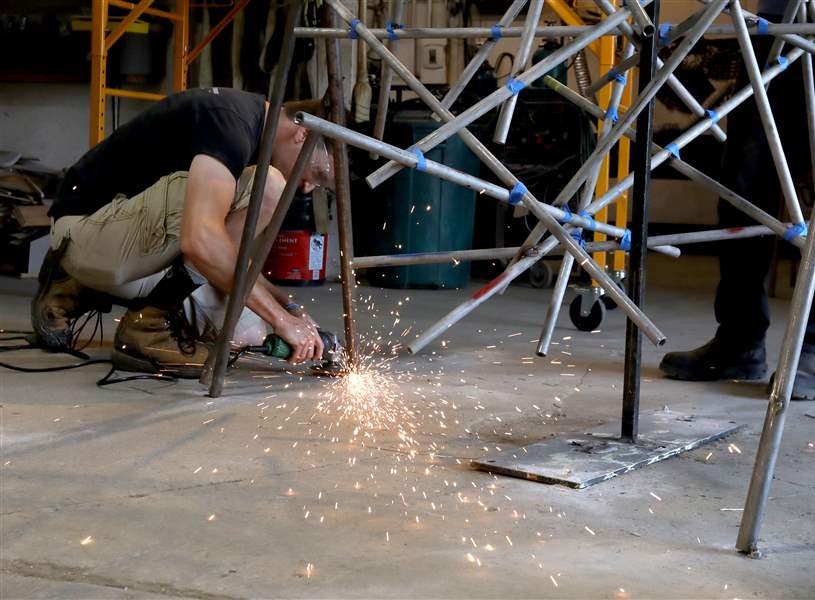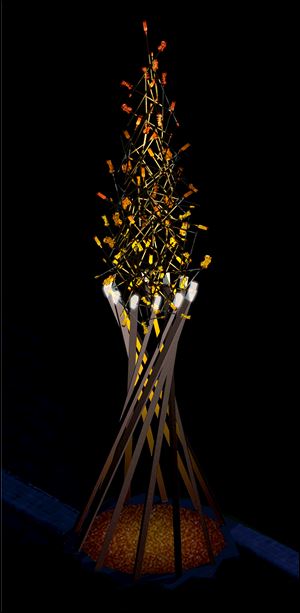
Sculpture uses shards of city's history to welcome the future
9/2/2018
Ian Thompson uses a saw to separate the Anthony Wayne Trail gateway sculpture from the floor at Flatlander's Sculpture in Blissfield, Mich.
The Blade/Lori King
Buy This Image
This month a drab, blighted entryway into downtown Toledo is being transformed into a portal that celebrates the city’s history of transformation, transportation, manufacturing, and innovation.
A realignment of the Anthony Wayne Trail flowing into the Erie and Lafayette streets intersection in the Warehouse District — a major passageway into the city — will include an artistic panorama flush with greenery, wildflowers, landforms, walls, and a 45-foot tall public art sculpture scheduled to be installed in the next few weeks. The project is a collaboration between city and state transportation officials and Toledo’s arts community leaders.

The Gateway sculpture, a tribute to Toledo's history, was designed by Laura and Tom Drugan of Seattle and fabricated locally at Flatlanders in Blissfield, Mich.
Although the realignment project’s ultimate goal was to be rid of a dangerous and awkward five-legged intersection at the end of the Trail that hindered both vehicle and foot traffic, it was apparent during the design phase about six years ago that collective heads had to come together to achieve what officials wanted to be a welcoming beacon into the city’s urban core, said Dave Dysard, planning administrator for Toledo’s division of engineering services.
“The right image of the heart of the region and the aesthetic elements were an important part of it, so we partnered early on with the arts commission,” Dysard said. “How the project looked, the aesthetics, were every bit as important, perhaps more important, than how well the roadway design worked.”
One of the final pieces to be installed as part of what has been called the Gateway Project, is a steel and glass centerpiece sculpture being fabricated by Flatlanders Sculpture Supply & Art Galleries in Blissfield, Mich. It is expected be installed on site next week and dedicated during a public ceremony onsite Oct. 18.
The artistic portion of the project cost about $628,000, including design costs totaling $87,338 that were budgeted from the city’s 1 Percent for Art program. The entire infrastructure project’s price tag was $7.7 million and was funded by local capital improvement funds and a $5.7 million federal transportation grant from the U.S. Department of Transportation, Dysard said.
The concept for the space at the Trail’s end was developed by the architectural duo of Laura Haddad and Tom Drugan with Haddad/Drugan, whose Seattle firm was commissioned by the Arts Commission of Greater Toledo to put together a design concept for the gateway. Haddad/Drugan was chosen from more than 130 artists who submitted proposals from all over the world, said Marc Folk, Arts Commission director.
The pair’s concept highlights the history of transportation along the Trail, from canals that made up the Miami & Erie Canal in the 19th Century, to the railroad lines that replaced the waterways in the early 20th Century before highway travel became king, and the rail lines were abandoned and the Trail constructed.
The duo, who started work on the Gateway in 2015, traveled frequently to Toledo to research and meet with neighborhood leaders before developing the design.
“We were really struck, and fascinated, by this rich layering of history that Toledo has with the themes we ended up picking up in the artwork — the industry, the design, the invention, innovation,” Drugan said.
The project’s design is derived from Toledo’s history as a main manufacturer of the bicycle wheel and its pinwheel spoke and the cut-glass patterns in pieces created by Libbey Glass, including 12 concrete “spokes” topped with old steel rail lines that radiate out in varying degrees from the sculpture.
The twisting motion of the design’s pieces create a spatial experience for the driver or pedestrian, who will experience peaks and valleys of landform as they move past different sections of the Gateway, eventually transitioning their trajectory upward with the sculpture, Haddad said.
“The rails are slanting so they have a sense of motion that points to the sculpture in the center,” she said. “So you go from this horizontal experience into a vertical experience of twisting and spinning.”
The sculpture will sit atop a 5-foot high concrete wall indicative of the canal walls of yesteryear, designed with a cut-glass pattern. Considered a continuum of the deconstructed wheel spokes in the landscape, 12 stainless or carbon steel tubes will rise diagonally 20 feet into the air and will be topped with stainless steel tubes shaped into a flame.
More than 60 glass pieces cast by local glass artist Jack Schmidt of Schmidt Messenger Studios in tones of amber, orange, and brilliant red will be placed at the end of each tube. The pieces, in the shapes of Toledo Scales, glass bottles, spark plugs, and Jeeps, further narrate Toledo’s history.
“We have not only this great identity in glass through glass manufacturing, and glass art, but you have a manufacturing identity in when we make components for things — our Libbey bottles, our Champion spark plugs, our Toledo Scales, the Jeep, and the innovation that came from the Libbey cut-glass bowl,” Folk said. “And then you have this opportunity to reclaim this entry point, and you have the opportunity to start to celebrate these histories as we use this site and the artwork as a way to serve as a welcoming beacon, a gateway to a revitalized urban core.”
The sculpture will include a lighting system to illuminate the pieces.
A final component of the project will be the landscaping, which will include wildflowers, swaths of trees, prairie grasses, perennials and flowering bulbs, and a butterfly garden. The parkland area will include walking paths, a seating wall, and a crushed-glass aggregate at the base of the sculpture.
“You can walk up into the sculpture and that glass aggregate is going to radiate from red to yellow to match the glass colors of the ornaments and to complement the plantings,” said Nathan Mattimoe, art in public places coordinator for the Arts Commission.
The infrastructure portion of the project includes crosswalks on all four legs of the intersection that will allow pedestrians easier access to a thriving downtown neighborhood.
“You can now walk across the street right into the heart of the Warehouse District and Saint Clair Street, so tremendous, tremendous improvement for the Warehouse District and the ability of pedestrians to get across the street there,” Dysard said.
Folk said the project plays off similar projects in the Glass City in which the arts community and civic leaders work in concert to elevate an infrastructure project to an artistic endeavor, including the programmable lighting system Bowling Green-based artist Erwin Redl is designing for installation on the Anthony Wayne Bridge in 2019, a project being done in conjunction with physical improvements to the suspension bridge.
“We have been able to engage regional, national, international creative talent in shaping the landscape of our city in places where we could have simply paved a road,” Folk said.
Contact Roberta Gedert at rgedert@theblade.com, 419-724-6075, or on Twitter @RoGedert.